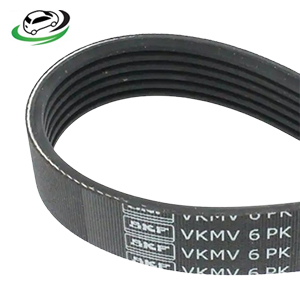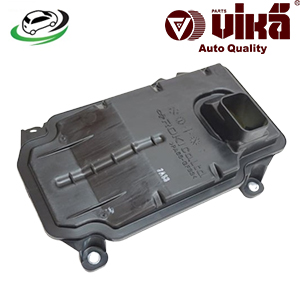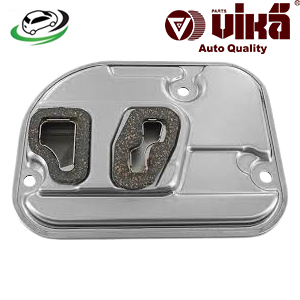-8%
Get Automatic Transmission Filter Audi 8U Q3-2.0T / VW CC-VR6/Passat B6-3.6L/Tiguan 1-2.0T/Tiguan 2-2.0T 09M325429
The automatic transmission filter is a crucial component in the automatic transmission system of a vehicle. It plays a vital role in maintaining the health and performance of the transmission by filtering contaminants from the transmission fluid. This overview will cover the design, function, importance, types, common issues, maintenance, and replacement of the automatic transmission filter.
Design and Function
The automatic transmission filter is designed to clean the transmission fluid before it circulates through the transmission components. This ensures that the fluid remains free from debris and contaminants that could otherwise cause damage or reduce performance.
Design:
- Construction: The filter typically consists of a metal or plastic housing that contains a filter element. The filter element is often made from a blend of paper, synthetic fibers, or mesh material that captures impurities.
- Filter Element: The filter element is designed to trap particles such as metal shavings, clutch material, and dirt. It is engineered to withstand high temperatures and pressures typical of the transmission environment.
- Mounting and Placement: The filter is usually mounted inside the transmission pan or attached to the transmission case. Its placement is strategic to ensure that all fluid passing through the transmission is filtered.
Functionality:
- Filtering Contaminants: The primary function of the automatic transmission filter is to remove contaminants from the transmission fluid. Contaminants can include metal particles, clutch material, and debris that can accumulate over time.
- Preventing Wear: By filtering out harmful particles, the filter helps prevent wear and tear on the transmission components. This contributes to smoother operation and extends the life of the transmission.
- Maintaining Fluid Quality: The filter helps maintain the quality of the transmission fluid by ensuring it remains clean. Clean fluid is essential for proper lubrication and cooling of transmission components.
Importance of the Automatic Transmission Filter
The automatic transmission filter is essential for several reasons:
- Ensuring Smooth Operation:
- Fluid Cleanliness: Clean transmission fluid is vital for smooth shifting and overall transmission performance. Contaminants in the fluid can cause erratic shifting, slipping, or hard shifts.
- Component Protection: The filter prevents debris from reaching critical transmission components, such as gears and valves. This helps avoid premature wear and potential failure.
- Preventing Transmission Damage:
- Avoiding Contamination: Contaminated transmission fluid can cause internal damage to the transmission, leading to costly repairs or replacements. The filter helps prevent such damage by trapping harmful particles.
- Extending Lifespan: By keeping the fluid clean, the filter contributes to the overall longevity of the transmission. Regular filter maintenance and replacement can help extend the transmission’s lifespan.
- Maintaining Fluid Pressure:
- Consistent Performance: The filter ensures that the transmission fluid remains at the correct pressure and viscosity, which is crucial for proper transmission operation. Proper fluid pressure ensures consistent shifting and reliable performance.
Types of Automatic Transmission Filters
Automatic transmission filters come in various types, each designed to suit different transmission systems and vehicle requirements. Common types include:
- Drop-in Filters:
- Design: Drop-in filters are typically made from a combination of metal and filter media. They are designed to fit directly into the transmission pan or case.
- Application: These filters are common in many standard automatic transmissions and are often used in both passenger vehicles and light trucks.
- Screen Filters:
- Design: Screen filters use a mesh or perforated screen to capture larger debris and particles. They are often used in conjunction with other types of filters.
- Application: Screen filters are used in some transmissions where additional filtration is required to protect sensitive components.
- Filter and Gasket Assemblies:
- Design: Some transmission filters come as part of a filter and gasket assembly, which simplifies installation and ensures a proper seal.
- Application: These assemblies are common in certain vehicle models and transmission types, providing a convenient solution for filter replacement.
- External Filters:
- Design: External filters are installed in the transmission cooler line and are designed to filter the fluid before it returns to the transmission.
- Application: External filters are often used in high-performance or heavy-duty applications where additional filtration is needed to handle higher stress levels.
Common Issues with Automatic Transmission Filters
Automatic transmission filters can experience various issues that affect their performance and the overall health of the transmission. Common problems include:
- Clogging:
- Causes: Over time, the filter can become clogged with debris and contaminants. This can occur due to normal wear, insufficient fluid changes, or the presence of excessive debris.
- Signs: Symptoms of a clogged filter include slipping gears, hard shifting, or erratic shifting. The transmission may also experience overheating due to restricted fluid flow.
- Leaks:
- Causes: Leaks can occur around the filter if it is improperly installed, if the gasket is damaged, or if the filter itself is defective.
- Signs: Look for signs of transmission fluid leaks under the vehicle or around the transmission pan. Low fluid levels and fluid spots on the driveway are common indicators.
- Contamination:
- Causes: Contamination can occur if the filter becomes damaged or if foreign particles bypass the filter. This can lead to increased wear and potential damage to the transmission.
- Signs: Contaminated fluid may appear dark or have a burnt smell. You may also notice unusual shifting behavior or performance issues.
- Filter Damage:
- Causes: Physical damage to the filter, such as cracks or tears, can compromise its effectiveness. Damage can result from improper handling, installation, or excessive pressure.
- Signs: Visible damage to the filter, such as cracks or tears, indicates the need for replacement. Unusual noises or transmission performance issues may also signal filter damage.
Maintenance and Inspection
Regular maintenance and inspection of the automatic transmission filter are essential for ensuring the smooth operation of the transmission. Here are some tips:
- Regular Fluid Changes:
- Follow Manufacturer’s Schedule: Adhere to the manufacturer’s recommended transmission fluid change intervals. Regular fluid changes help keep the filter clean and maintain fluid quality.
- Check Fluid Condition: Monitor the condition of the transmission fluid regularly. If the fluid appears dirty or has a burnt smell, it may indicate a problem with the filter or other components.
- Inspect the Filter:
- Check for Leaks: Periodically inspect the filter and surrounding area for signs of leaks. Address any leaks promptly to prevent fluid loss and potential damage.
- Examine the Filter Element: During routine maintenance, examine the filter element for signs of clogging, damage, or excessive wear. Replace the filter if necessary.
- Replace the Filter:
- Follow Replacement Intervals: Replace the automatic transmission filter according to the manufacturer’s recommendations or when signs of issues are observed.
- Use Quality Parts: When replacing the filter, use high-quality parts that meet or exceed the manufacturer’s specifications. Proper installation and the use of quality parts ensure optimal performance.
Replacing the Automatic Transmission Filter
Replacing the automatic transmission filter involves several steps, but with the right tools and careful attention, it can be accomplished effectively. Here’s a general guide:
- Preparation:
- Gather Tools and Parts: You’ll need a new transmission filter, gasket (if required), transmission fluid, and basic hand tools.
- Consult the Manual: Refer to the vehicle’s service manual for specific instructions and specifications related to filter replacement.
- Drain the Transmission Fluid:
- Locate the Drain Plug: Find the transmission fluid drain plug or pan bolts. Place a drain pan underneath to catch the fluid.
- Remove the Fluid: Carefully drain the old transmission fluid. Allow sufficient time for the fluid to drain completely.
- Remove the Old Filter:
- Remove the Pan: If the filter is inside the transmission pan, remove the pan by loosening the bolts. Be prepared for additional fluid to drain out when the pan is removed.
- Remove the Filter: Locate the old filter and carefully remove it from its mounting position. Note the filter’s orientation for proper installation of the new filter.
- Install the New Filter:
- Position the New Filter: Place the new filter in the correct position, ensuring it aligns properly with the mounting points.
- Reattach the Pan: If the filter is inside the pan, clean the pan and gasket surfaces before reattaching. Install the pan with a new gasket if required.
- Refill Transmission Fluid:
- Add New Fluid: Refill the transmission with the recommended type and amount of fluid. Follow the manufacturer’s specifications for proper fluid levels.
- Check for Leaks: Start the engine and let it run for a few minutes, checking for any signs of leaks around the filter and pan.
- Final Checks:
- Check Fluid Level: With the engine running, check the transmission fluid level using the dipstick (if applicable). Add more fluid if necessary to reach the correct level.
- Test Drive: Take the vehicle for a short test drive to ensure proper shifting and overall performance. Monitor for any unusual noises or issues.
Follow us on Facebook for more parts.



